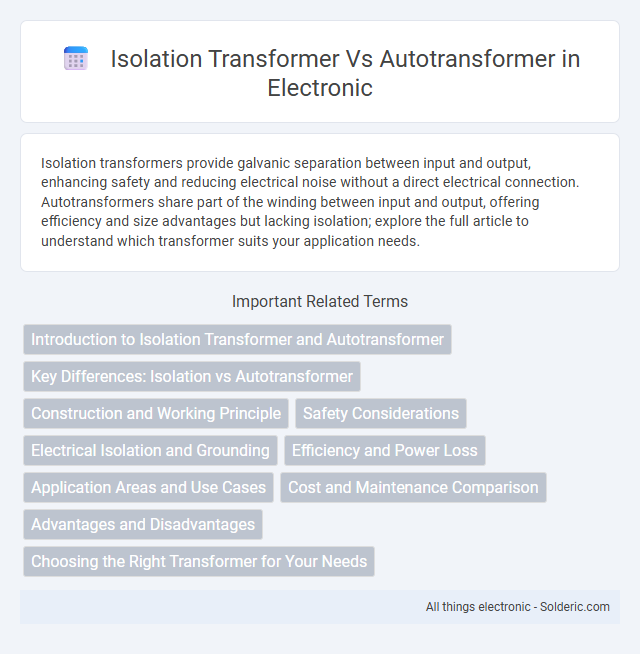Isolation transformers provide galvanic separation between input and output, enhancing safety and reducing electrical noise without a direct electrical connection. Autotransformers share part of the winding between input and output, offering efficiency and size advantages but lacking isolation; explore the full article to understand which transformer suits your application needs.
Comparison Table
| Feature | Isolation Transformer | Autotransformer |
|---|---|---|
| Design | Separate primary and secondary windings | Single winding with taps |
| Voltage Transformation | Complete electrical isolation, same or different voltages | Voltage step-up or step-down with common winding |
| Electrical Isolation | Provides full galvanic isolation | No galvanic isolation; primary and secondary share a common connection |
| Size & Weight | Large and heavy | Smaller and lighter |
| Cost | Higher cost | Lower cost |
| Application | Safety isolation, noise reduction, sensitive equipment | Voltage regulation, voltage step-up or step-down in power distribution |
| Efficiency | Lower efficiency due to separate windings | Higher efficiency due to less copper use |
| Short Circuit Current | Limits fault current due to isolation | Higher short circuit currents possible |
Introduction to Isolation Transformer and Autotransformer
Isolation transformers provide galvanic isolation between input and output, enhancing safety by preventing direct electrical connection and reducing noise interference in sensitive equipment. Autotransformers share a common winding for primary and secondary, offering a more compact design and higher efficiency, but lack electrical isolation. Your choice depends on whether safety isolation or size and cost efficiency is the priority in your application.
Key Differences: Isolation vs Autotransformer
Isolation transformers have separate primary and secondary windings, providing galvanic isolation that enhances safety by preventing direct electrical connection and reducing noise interference. Autotransformers feature a single winding with taps serving as both primary and secondary, offering a more compact, cost-effective design but lacking electrical isolation. The key difference lies in isolation transformers protecting against electrical faults and noise, while autotransformers prioritize efficiency and reduced size without isolation benefits.
Construction and Working Principle
Isolation transformers consist of two electrically separated windings--primary and secondary--wound on a common core, transferring energy through electromagnetic induction while providing galvanic isolation. Autotransformers feature a single winding with taps that serve as both primary and secondary, allowing part of the winding to be common to both circuits, which results in a more compact design but lacks electrical isolation. The construction difference directly impacts the working principle: isolation transformers use separate coils to isolate and transfer power, whereas autotransformers rely on a shared winding to adjust voltage levels efficiently without isolation.
Safety Considerations
Isolation transformers provide galvanic isolation, significantly reducing the risk of electric shock by separating the primary and secondary windings, making them ideal for sensitive medical or industrial equipment. Autotransformers share a common winding between the input and output, which does not offer isolation and increases the risk of shock and short circuits if insulation fails. Choosing an isolation transformer enhances safety in critical applications where electrical separation and fault protection are essential.
Electrical Isolation and Grounding
An isolation transformer provides full electrical isolation between the primary and secondary windings, enhancing safety by preventing direct electrical connection and minimizing ground loop noise. In contrast, an autotransformer shares common windings between primary and secondary, offering no true isolation and potentially allowing ground faults to propagate. Proper grounding is essential for isolation transformers to maintain protective separation, while autotransformers require careful consideration to avoid unintended grounding paths that could compromise system safety.
Efficiency and Power Loss
Isolation transformers typically exhibit slightly lower efficiency and higher power loss compared to autotransformers due to their separate primary and secondary windings, which increase resistive and core losses. Autotransformers, sharing a common winding for both input and output, minimize copper usage and reduce energy dissipation, resulting in higher efficiency and lower power loss. Your choice depends on whether electrical isolation or maximum efficiency and minimal power loss is the priority in your application.
Application Areas and Use Cases
Isolation transformers are widely used in medical equipment, sensitive electronic devices, and industrial control systems to provide electrical isolation and reduce noise interference, enhancing safety and signal integrity. Autotransformers find applications in voltage regulation, motor starting, and power distribution systems where size, weight, and cost efficiency are critical, but electrical isolation is not required. Both types of transformers serve specific roles: isolation transformers for safety-critical environments and autotransformers for efficient voltage adjustment in large-scale electrical networks.
Cost and Maintenance Comparison
Isolation transformers typically have higher initial costs and maintenance expenses due to their complex construction and thicker insulation required for electrical isolation. Autotransformers are more cost-effective and have lower maintenance requirements, as they use a single winding and fewer materials, resulting in simpler design and reduced weight. Choosing between the two depends on budget constraints and the need for electrical isolation in the application.
Advantages and Disadvantages
Isolation transformers provide galvanic isolation, enhancing safety by preventing direct electrical connection between input and output, which reduces electrical noise and improves equipment protection. However, they are bulkier, heavier, and typically more expensive than autotransformers. Autotransformers offer higher efficiency, smaller size, and lower cost but lack isolation, which can pose safety risks and increase susceptibility to electrical faults, making them less suitable for sensitive or hazardous applications.
Choosing the Right Transformer for Your Needs
Selecting between an isolation transformer and an autotransformer hinges on your application requirements and safety considerations. Isolation transformers provide galvanic isolation, enhancing electrical safety and noise reduction in sensitive equipment, making them ideal for medical or industrial settings. Autotransformers offer a more compact, cost-effective solution for voltage adjustment but lack isolation, so they are best suited for applications where electrical isolation is not critical.
isolation transformer vs autotransformer Infographic

 solderic.com
solderic.com